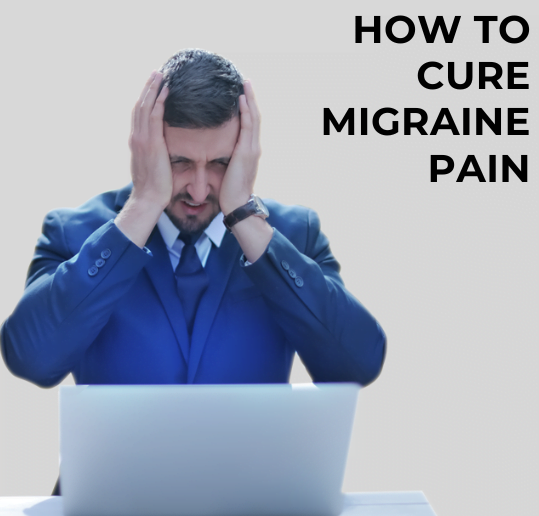In this article, you will find a complete guide on how to cure migraine pain to prevent it. Curing migraine pain is a matter of serious concern, as migraine affects both mental and physical health adversely. As a complex neurological disorder, migraine goes beyond a simple headache. It appears as recurrent attacks of throbbing pain, usually localized to one side of the head. But their effects go far deeper than physical pain. Migraine pain accompanies headache discomfort and other symptoms like nausea, vomiting, or increased sensitivity to light, sound, and scent. Although the precise cause of migraine is yet unknown, a confluence of neurological abnormalities, environmental variables, and genetic predisposition plays a role in its development.
To cure migraine pain, it is necessary to know about migraine triggers, which enhance the symptoms of migraine. Certain foods, hormonal shifts, stress, altered sleep habits, or environmental factors are different triggers for the pain. Migraine is still not well understood or adequately addressed, even with its widespread occurrence. Due to the severe effects on quality of life, a comprehensive strategy including targeted medication, stress-reduction strategies, and lifestyle changes is required to cure migraine pain. Employing comprehension, compassion, and well-informed action, the impact of migraine on individuals suffering from it can be reduced.

The Symptoms of Migraine pain
The symptoms of migraine must be known to cure migraine pain. The symptoms of migraines fluctuate greatly from person to person and from episode to episode. A severe headache, usually on one side of the head, frequently characterized as throbbing or pulsating, is the classic sign of a migraine. In addition to these, migraine sufferers can have other symptoms, such as:
1. Aura
Before or during a migraine attack, some people experience sensory disruptions that can impair speech, vision, or feeling. Common signs of an aura include visual abnormalities including flashing lights, zigzag lines, blind spots, or momentary vision loss. Numbness or tingling is common in sensory auras, typically beginning in the hands and moving to the face or arms. Auras can less frequently make it difficult to communicate or understand language.
2. Nausea and vomiting
During or before migraine attacks, gastrointestinal symptoms, including nausea, vomiting, or an upset stomach, are common among migraine sufferers.
3. Light sensitivity (photophobia)
Glare or bright lights can intensify migraine symptoms, pain, or discomfort. People with migraines frequently look for calm or dark places to reduce their exposure to stimuli.
4. Phonophobia, or sensitivity to sound
Loud noises or specific sounds can initiate and aggravate migraine symptoms.
5. Smell and taste sensitivity
During migraine attacks, strong smells or particular foods may become uncomfortable, causing nausea or vomiting.
6. Neck stiffness
Tension or stiffness in the shoulders or neck might occur in some people before or during a migraine attack, which enhances headache discomfort.
7. Cognitive symptoms
During an attack, migraines may impair memory, making it difficult to focus on something.
Further, some people may suffer from “silent migraines,” which are migraines that do not cause headache pain but do cause other symptoms like aura or gastrointestinal problems.
Causes of Migraine pain
Migraine is a complicated neurological disorder with different causes. The following variables play a role in the onset of migraines:
1. Genetics
Family history plays a major role in causing migraines. The probability of having migraines is higher if one or both parents have a history of migraines.
2. Neurological Imbalances
Deviations in the levels of substances in the brain, like noradrenaline, serotonin, and dopamine, may cause migraines. These neurotransmitters are involved in mood and pain regulation, and changes in their levels can set off migraine attacks.
3. Triggers
Various environmental, nutritional, hormonal, emotional, and lifestyle factors or variables can cause migraines. Hormone variations (particularly in women during menstruation or pregnancy), dehydration, stress, anxiety, abnormal sleep habits, and specific foods (such as old cheese, chocolate, and processed meats) are major factors in causing migraines.
Important Tips to Cure Migraine pain
Every person experiences migraines differently. Migraine attacks occur less frequently and with less intensity if triggers are recognized and managed by receiving the proper medical care and making lifestyle adjustments. You can lessen the frequency and intensity of migraine attacks by putting these preventive techniques into practice. The following preventive measures can help cure migraines:
1. Recognize and avoid triggers
Maintain a record of possible triggers, including particular meals, hormone fluctuations, stress, sleep patterns, and environmental elements like shifting the weather or sensory stimuli, and strive to limit or avoid being around them.
2. Adopt a regular sleep schedule
Have a proper rest and maintain scheduled sleeping and waking times each day.
3. Control stress
Stress is frequently the cause of migraines. Practice stress-reduction methods like frequent exercise, deep breathing, yoga, meditation, or relaxation techniques. Cycling, swimming, and walking are also helpful.
4. Drink water and eat regular meals
Dehydration and missing meals cause migraines. So stay hydrated throughout the day and eat well-balanced meals at regular intervals.
5. Limit alcohol and caffeine
Restrict excessive amounts of alcohol or caffeine consumption because excessive alcohol or caffeine intake increases the risk of migraine.
6. Work out frequently

Spend almost 30 minutes daily performing exercises like cycling, jogging, yoga, or walking. Exercise improves mood, lowers stress, and lessens the frequency and intensity of migraine attacks.
7. Consider dietary adjustments
Avoid specific foods that cause migraines, such as chocolate, aged cheeses, processed meats, and meals with artificial chemicals like aspartame or MSG. Eat balanced diet to cure migraine pain.
Read more. “A Complete Guide to a Balanced Diet and its Benefits.”
8. Alternative therapies
Acupuncture, massage therapy, biofeedback, and cognitive behavioral therapy (CBT) are among the therapies that may help treat migraines. These methods can lessen migraine symptoms, enhance coping mechanisms, and lower stress.
9. Speak with a medical specialist

Consult healthcare professionals and take prescribed medications to control the migraine.
A medical specialist assists in determining triggers, looking into available treatments, and modifying preventative strategies as necessary.
In conclusion, the above-discussed are important tips to cure and prevent migraines. Managing migraines is difficult and frequently incapacitating, but keep in mind that you may effectively manage your migraines and lessen their impact on your everyday life by being proactive in identifying triggers, changing your lifestyle, and seeking appropriate therapy.


